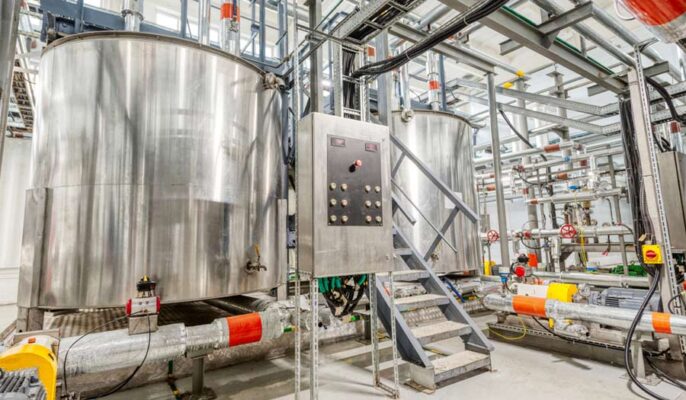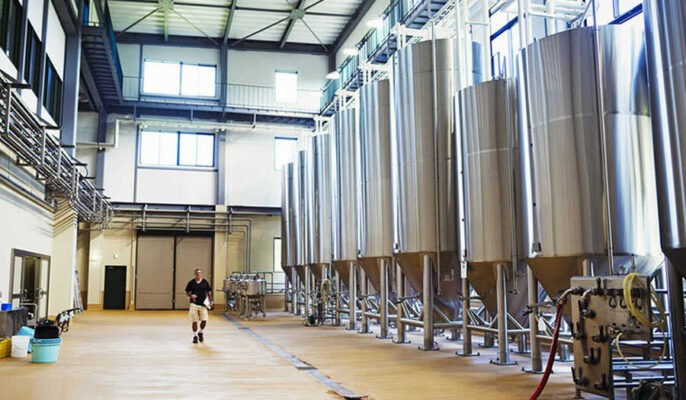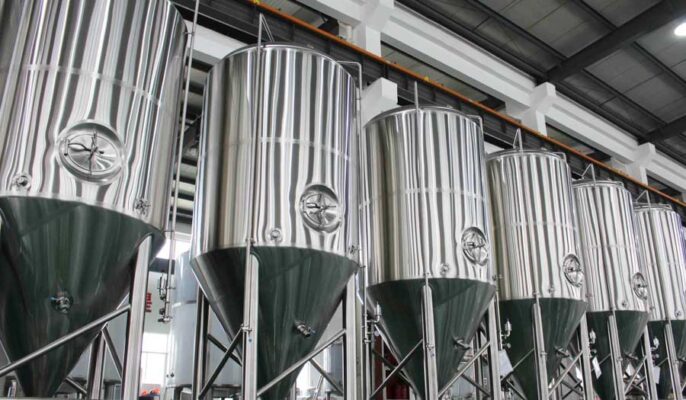Electric heating is an efficient, controllable and safe heating method used extensively in electric heating beer brewing equipment. This guide provides a comprehensive overview of various electric heating systems used in beer brewing.
Introduction to Electric Heating for Beer Brewing
Electric heating offers several benefits for beer production:
- Precise temperature control for mashing, boiling, etc.
- Clean heating with no fumes or combustion byproducts
- Even and consistent heat distribution
- Compact, fast-response heating elements
- Safe for food contact and hazard-free operation
- Energy-efficient and lower operating costs
- Automation and process control integration
electric heating beer brewing equipment methods for brewing equipment:
- Electric steam boilers
- Electric hot water boilers
- Electric kettles
- Electric brewing vessels
- Electric heating jackets
- Electric immersion heaters
- Electric tank/fermenter heaters
Applications in Brewing
Electric heating systems are used in:
- Mashing vessels
- Lauter tuns
- Brew kettles
- Whirlpools
- Hot liquor tanks
- Yeast propagation
- Fermentation tanks
- Bright beer tanks
- CIP systems
- Bottle/keg washers
- Pipe heating
Electric Steam Boilers
Electric steam boilers use electrodes or heating elements to generate steam for brewing:
Features:
- Fast steaming with rapid startup
- Compact, skid-mounted units
- Fully automatic operation
- Precise pressure and temperature control
- Descaling and blowdown capabilities
- Higher energy-efficiency
Advantages:
- Provides very dry, high-quality steam
- No combustion residues or air pollutants
- Low maintenance without burner cleaning
- Safe and clean operation
- Long working life of electrodes
- Lower operating costs
Electric steam boilers are available up to 50,000 lbs/hr steam capacity for large breweries.

Electric Hot Water Boilers
Electric hot water boilers heat water for mashing, cleaning, etc.:
Features:
- Compact design for limited spaces
- Fast ramp-up and response
- Precise digital temperature control
- Durable stainless steel construction
- Automatic water feed and safety systems
- Integrated controls and data logging
Benefits:
- Provides stable hot water supply on demand
- Consistent temperature regulation
- Even heating and no cold spots
- Descaling and blowdown capabilities
- Lower maintenance without combustion
- Safe, clean and efficient operation
Electric hot water boilers up to 500 kW capacity are suitable for most commercial brewing needs.
Electric Brewing Kettles
Electric kettles equipped with heating elements are used for wort boiling:
Features:
- Heating elements encased in stainless chambers
- Power rating from 50 kW to 500 kW
- Steam/water heating jackets also available
- Rugged stainless steel inner vessel
- Insulated vessel to minimize heat loss
- Automated temperature controls
Benefits:
- Rapid wort heating and boiling
- Precise temperature control
- Energy-efficient and lower power costs
- Reduced boiling times
- Consistent, high-quality wort
- Lower maintenance without burners
- Safer operation without hot flames
Electric kettles are available from 100 gallon to 600 barrel capacities.
Electric Heating Jackets
Electric heating jackets encase tanks and vessels:
Features:
- Custom-designed jackets for tanks
- Flexible heating elements conform to shape
- Insulated wraps for energy efficiency
- Made from food-grade materials
- Can sustain CIP and sterilization
- Integrated temperature controls
Benefits:
- Provides uniform vessel heating
- Better temperature control than burners
- Safer operation without live steam
- Reduced system footprint with no boilers
- Easy integration into existing tanks
- Lower maintenance than steam jackets
Heating jackets are commonly used for fermenters, yeast propagation, bright beer tanks, etc.
Electric Immersion Heaters
Immersion heaters provide in-tank heating:
Features:
- Compact stainless steel construction
- Sheath element directly immersed in liquid
- Power rating from 3 kW to 200 kW
- Customized heating capacity and length
- Integrated controls and safety systems
Advantages:
- Faster heating directly within liquid
- Compact, scalable, inexpensive
- Zoned heating possible in vessels
- Easier installation than external heating
- No contamination like direct steam injection
- Energy-efficient and low maintenance
Immersion heaters are used for hot liquor tanks, mash filtration, CIP, fermentation, etc.
Electric Tank and Vessel Heaters
Electric heaters are engineered for specific vessels:
Features:
- Custom designed for vessels
- Flanged or clamped electrics heaters
- Insulated wraparound or underside heaters
- Integrated controls and safety systems
- Power rating from 5 kW to 500 kW
Benefits:
- Optimized heating solution for vessels
- Compact and faster heating
- More efficient than external heating
- Lower maintenance than steam coils
- Safer operation without hot pipes
- Precise temperature control
Used for mash tuns, hot liquor tanks, yeast propagation tanks, fermenters, etc.

Technical Specifications
Below are typical specifications of electric heating systems:
| Type | Capacity | Voltage | Power | Material | Controls |
|---|---|---|---|---|---|
| Electric steam boiler | 10,000 lbs/hr | 480V 3-ph | 1,000 kW | Stainless steel | PLC + HMI |
| Electric hot water boiler | 100 kW | 380V 3-ph | 150 kW | Carbon steel | Digital PID |
| Electric kettle | 600 gallons | 480V 3-ph | 600 kW | Stainless steel | PLC |
| Heating jacket | 10 bbl fermenter | 480V 3-ph | 20 kW | Stainless steel, silicone | PID, sensors |
| Immersion heater | 10 kW | 380V 3-ph | 12 kW | Stainless steel | Thermostat |
| Tank heater | 10,000 liter HLT | 480V 3-ph | 150 kW | Stainless steel | PLC, touchscreen |
Suppliers and Pricing
Some leading electric heating equipment suppliers and sample pricing:
| Company | Location | Price Range |
|---|---|---|
| Columbia Boiler Co | USA | $8,000 – $150,000 |
| Indeeco | USA | $5,000 – $100,000 |
| Chromalox | UK | $10,000 – $200,000 |
| Rite Boilers | India | $3,000 – $50,000 |
| Innovative Heating | Canada | $6,000 – $120,000 |
- Small immersion heaters start from $3,000
- Large steam boilers up to $150,000
- Custom tanks and vessels $50,000 to $250,000
Pricing depends on capacity, construction material, controls, customization, etc.
Installation and Commissioning
Proper installation guidelines must be followed:
- Careful lifting and positioning of equipment
- Mounting boilers and vessels on strong base
- Checking alignments and clearances
- Tightening flanges and fittings
- Connecting instrumentation and controls
- Venting air and hydro testing
- Insulation and lagging jackets
- Programming control parameters
- Trial runs and optimization
Vendors provide documentation for installation and startup. Certified technicians commission the electric heating systems.
Operation and Maintenance
Operating procedures and maintenance guide:
Operation:
- Startup and shutdown with warming up
- Adjusting temperature set points
- Monitoring power, current, voltages
- Checking steam pressures or flow
- Verifying control valves operation
- Testing safety shut-offs and alarms
- Inspecting equipment for any leaks, damage
Maintenance:
- Daily checks and cleaning
- Descaling and blowdown
- Replacing damaged insulation
- Checking terminals, switches
- Verifying connections and fittings
- Testing safety valves
- Regular lubrication
- Inspecting heating elements
Choosing the Right Electric Heating System
Factors for selecting the ideal electric heating solution:
1. Application
- Type of brewing process step
- Production volumes and batch sizes
- Temperature and pressure requirements
- Clean-in-place needs
- Existing utilities and infrastructure
2. Capacity
- Power rating and heat duty
- Temperature specifications
- Volume to be handled
- Throughput and production rates
3. Construction
- Compact or modular configurations
- Material grade for food contact
- Layout, size and clearances
- Access for maintenance and cleaning
4. Controls
- Level of automation needed
- Data monitoring and acquisition
- Integration with central system
- Safety interlocks and redundancy
5. Supplier
- Industry experience and expertise
- Custom engineering capabilities
- Local presence and support infrastructure
- Compliance with regulations
- Installation and training services
Understanding brewing requirements and comparing supplier options on these criteria ensures selection of the optimal electric heating system with maximum return on investment.
Pros and Cons of Electric Heating
Advantages
- Precise temperature control
- Fast response times and ramp-up
- Energy efficient and lower operating costs
- Reduce boil times and duration
- Improve wort and beer quality
- Compact, scalable systems
- Lower maintenance requirements
- Clean operation with minimum emissions
Disadvantages
- High initial investment cost
- May require new electrical infrastructure
- Limited capacities for very large breweries
- Controls and sensors add complexity
- Require skilled personnel for usage
- Additional automation integration needed
- Requires specialist vendor selection
Common Problems and Solutions
Some problems and corrective actions:
| Issue | Possible Causes | Solution |
|---|---|---|
| Overheating | Sensor failure | Check and replace sensors |
| Loose connections | Inspect terminals and tighten | |
| Scale deposits | De-scale heating elements | |
| Temperature fluctuations | Damaged insulation | Repair or replace insulation |
| Control loop issues | Tune PID parameters, check wiring | |
| Boiler load variations | Balance steam demand | |
| Tripping of breakers | Overload | Ensure properly rated breakers |
| Short circuit | Inspect wiring and insulation | |
| Damaged heating elements | Replace damaged elements |
FAQs
Q: What heating capacity is needed for 20 bbl brewing system?
A: Approximately 400 kW steam boiler or 650 kW electric hot water boiler capacity.
Q: What temperature can electric kettles achieve?
A: Up to 140°C based on power rating, with precise control.
Q: How is watt density decided for heating jackets?
A: Based on vessel insulation, heat loss, temperature requirements and batch size. Typically 10-30 W/in2.
Q: Can electric heating replace steam heating?
A: Yes, electric systems provide better control and lower emissions. But higher initial cost.
Q: What materials are used for electric heating?
A: Stainless steel for food contact. Steel vessel with silicon jackets also common.
Q: Is electric heating safe for beer production?
A: Yes, electric systems provide clean operation with no contamination when properly designed.
Q: How is energy efficiency maximized?
A: Optimized insulation, heating zones, advanced controllers, hybrid electric-steam combinations.
Q: What maintenance is required?
A: Descaling, cleaning, sensor calibration, heating element inspection, wire and terminal checks.
Conclusion
Electric heating systems provide clean, efficient and controllable solutions for commercial beer production. With comprehensive process expertise and advanced brewing-specific designs, vendors can provide customized electric heating configurations integrated into the brewing process. By selecting the optimal system based on required specifications and budget, brewers can benefit from enhanced quality, lower operating costs, safer operations, reduced emissions and precise control over heating profiles, a critical factor in producing great tasting beers consistently. With a wide range of electrical heating systems available and their advantages, many breweries are choosing to go electric for their heating needs.





